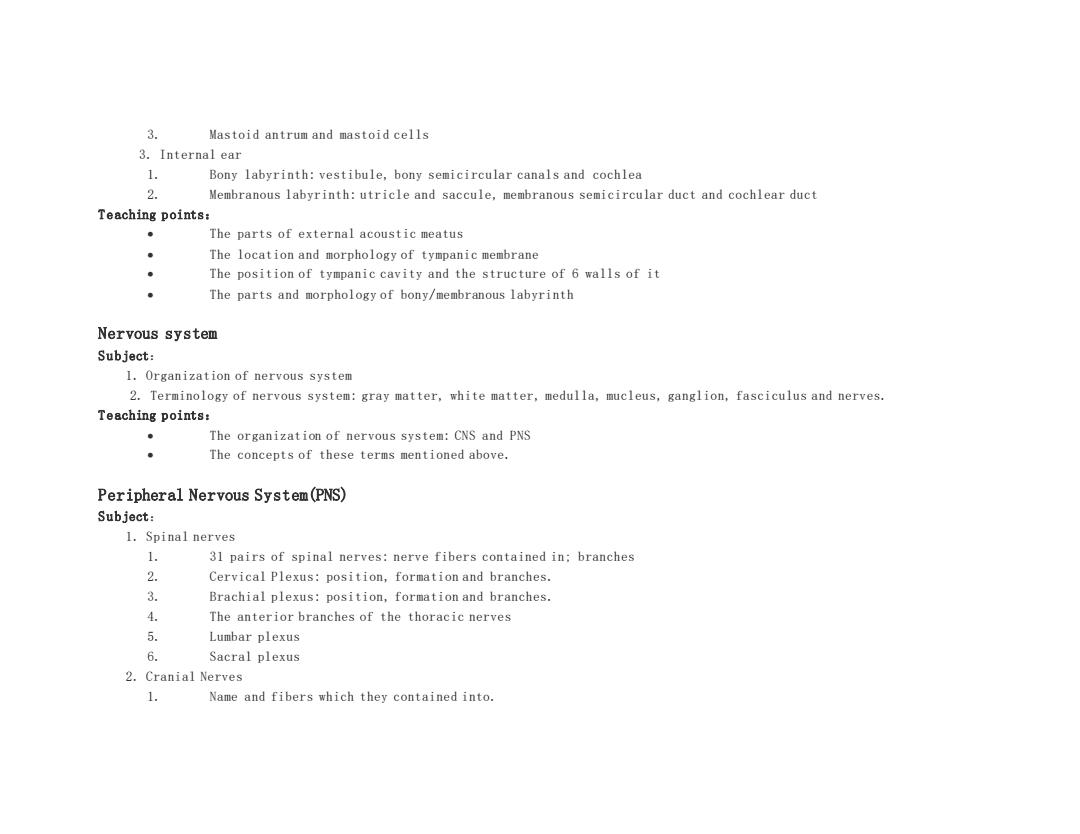
3. Mastoid antrum and mastoid cells 3.Internal ear 1. Bony labyrinth:vestibule,bony semicircular canals and cochlea 2. Membranous labyrinth:utricle and saccule,membranous semicircular duct and cochlear duct Teaching points: The parts of external acoustic meatus The location and morphology of tympanic membrane The position of tympanic cavity and the structure of 6 walls of it The parts and morphology of bony/membranous labyrinth Nervous system Subject: 1.Organization of nervous system 2.Terminology of nervous system:gray matter,white matter,medulla,mucleus,ganglion,fasciculus and nerves. Teaching points: The organization of nervous system:CNS and PNS The concepts of these terms mentioned above. Peripheral Nervous System(PNS) Subject: 1.Spinal nerves ( 31 pairs of spinal nerves:nerve fibers contained in:branches 2. Cervical Plexus:position,formation and branches. 3. Brachial plexus:position,formation and branches 4. The anterior branches of the thoracic nerves 5. Lumbar plexus 6. Sacral plexus 2.Cranial Nerves 1. Name and fibers which they contained into
3. Mastoid antrum and mastoid cells 3. Internal ear 1. Bony labyrinth: vestibule, bony semicircular canals and cochlea 2. Membranous labyrinth: utricle and saccule, membranous semicircular duct and cochlear duct T e aching p oints: • The parts of external acoustic meatus • The location and morphology of tympanic membrane • The position of tympanic cavity and the structure of 6 walls of it • The parts and morphology of bony/membranous labyrinth Nervous system S u bject: 1. Organization of nervous system 2. Terminology of nervous system: gray matter, white matter, medulla, mucleus, ganglion, fasciculus and nerves. T e aching p oints: • The organization of nervous system: CNS and PNS • The concepts of these terms mentioned above. Peripheral Nervous System(PNS) S u bject: 1. Spinal nerves 1. 31 pairs of spinal nerves: nerve fibers contained in; branches 2. Cervical Plexus: position, formation and branches. 3. Brachial plexus: position, formation and branches. 4. The anterior branches of the thoracic nerves 5. Lumbar plexus 6. Sacral plexus 2. Cranial Nerves 1. Name and fibers which they contained into
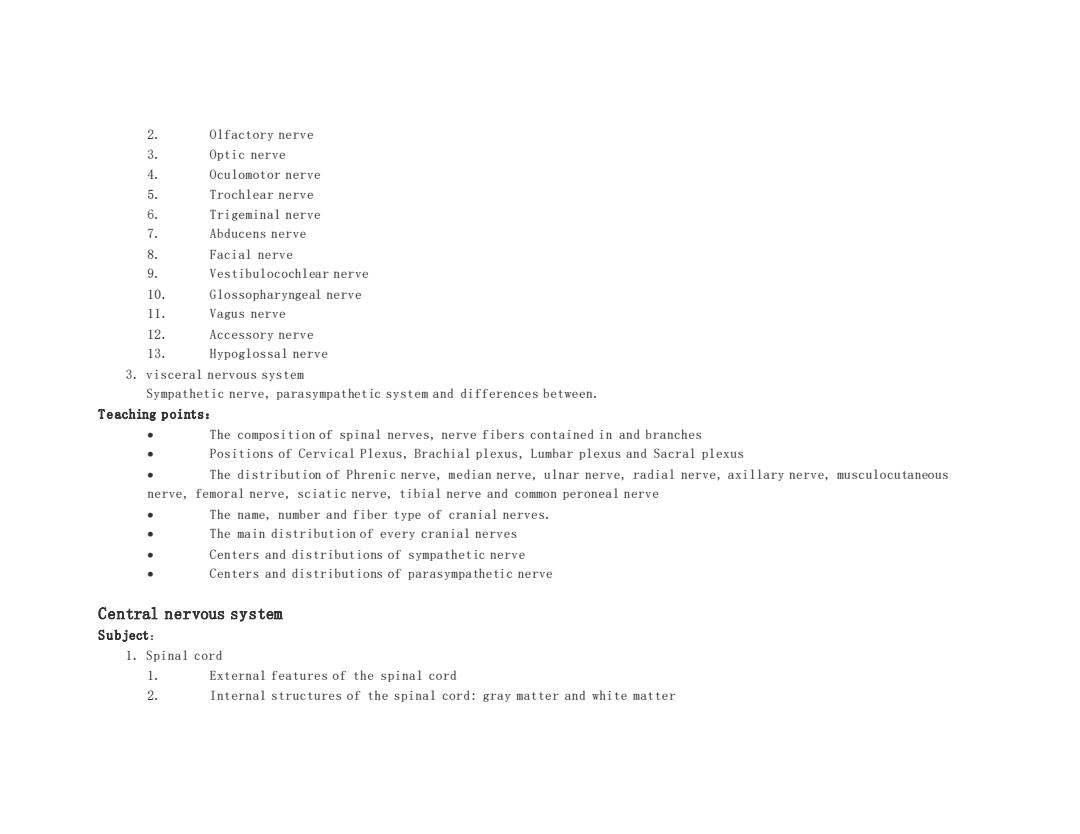
2. 0lfactory nerve 3. Optic nerve 4. Oculomotor nerve 5. Trochlear nerve 6. Trigeminal nerve 1 Abducens nerve 8. Facial nerve 9. Vestibulocochlear nerve 10. Glossopharyngeal nerve 11. Vagus nerve 12. Accessory nerve 13. Hypoglossal nerve 3.visceral nervous system Sympathetic nerve,parasympathetic system and differences between. Teaching points: The composition of spinal nerves,nerve fibers contained in and branches Positions of Cervical Plexus,Brachial plexus,Lumbar plexus and Sacral plexus The distribution of Phrenic nerve,median nerve,ulnar nerve,radial nerve,axillary nerve,musculocutaneous nerve,femoral nerve,sciatic nerve,tibial nerve and common peroneal nerve The name,number and fiber type of cranial nerves. The main distribution of every cranial nerves Centers and distributions of sympathetic nerve Centers and distributions of parasympathetic nerve Central nervous system Subject: I.Spinal cord 1. External features of the spinal cord 2. Internal structures of the spinal cord:gray matter and white matter
2. Olfactory nerve 3. Optic nerve 4. Oculomotor nerve 5. Trochlear nerve 6. Trigeminal nerve 7. Abducens nerve 8. Facial nerve 9. Vestibulocochlear nerve 10. Glossopharyngeal nerve 11. Vagus nerve 12. Accessory nerve 13. Hypoglossal nerve 3. visceral nervous system Sympathetic nerve, parasympathetic system and differences between. T e aching p oints: • The composition of spinal nerves, nerve fibers contained in and branches • Positions of Cervical Plexus, Brachial plexus, Lumbar plexus and Sacral plexus • The distribution of Phrenic nerve, median nerve, ulnar nerve, radial nerve, axillary nerve, musculocutaneous nerve, femoral nerve, sciatic nerve, tibial nerve and common peroneal nerve • The name, number and fiber type of cranial nerves. • The main distribution of every cranial nerves • Centers and distributions of sympathetic nerve • Centers and distributions of parasympathetic nerve Central nervous system S u bject: 1. Spinal cord 1. External features of the spinal cord 2. Internal structures of the spinal cord: gray matter and white matter
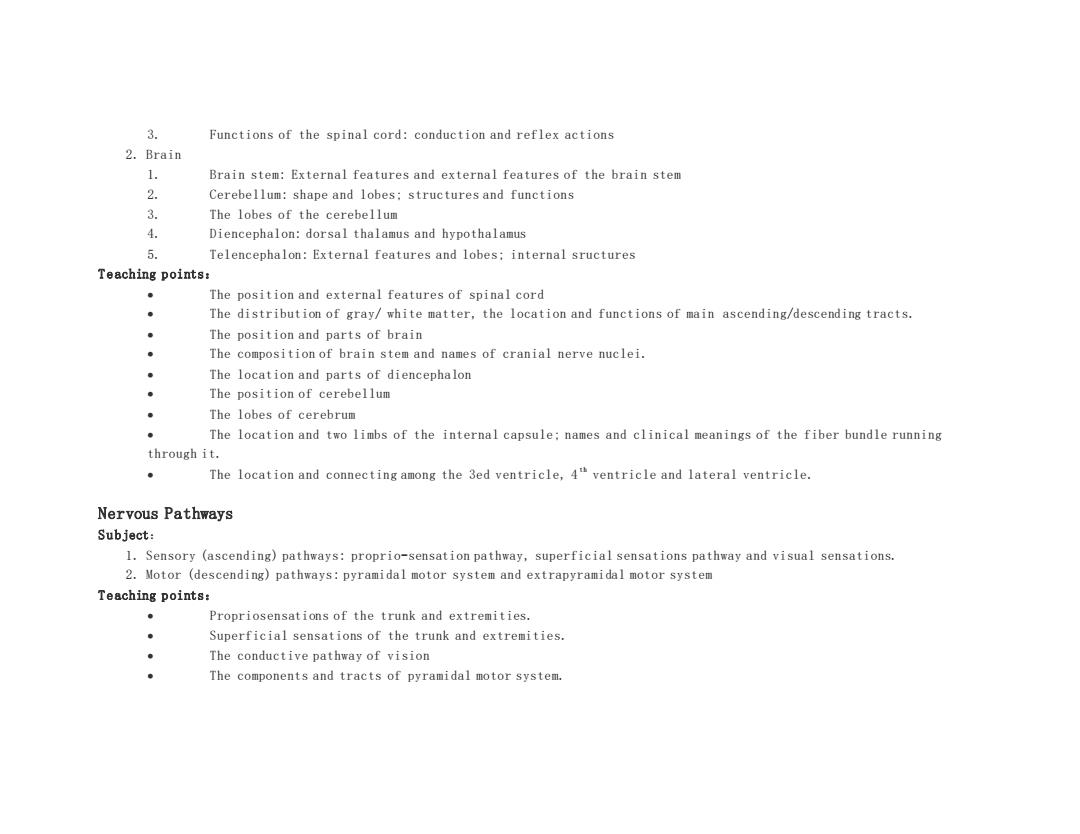
3. Functions of the spinal cord:conduction and reflex actions 2.Brain 1. Brain stem:External features and external features of the brain stem 2. Cerebellum:shape and lobes:structures and functions 3. The lobes of the cerebellum 4. Diencephalon:dorsal thalamus and hypothalamus 5. Telencephalon:External features and lobes:internal sructures Teaching points: The position and external features of spinal cord The distribution of gray/white matter,the location and functions of main ascending/descending tracts. The position and parts of brain The composition of brain stem and names of cranial nerve nuclei. The location and parts of diencephalon The position of cerebellum The lobes of cerebrum The location and two limbs of the internal capsule:names and clinical meanings of the fiber bundle running through it. The location and connecting among the 3ed ventricle,4"ventricle and lateral ventricle. Nervous Pathways Subject: 1.Sensory (ascending)pathways:proprio-sensation pathway,superficial sensations pathway and visual sensations. 2.Motor (descending)pathways:pyramidal motor system and extrapyramidal motor system Teaching points: Propriosensations of the trunk and extremities. Superficial sensations of the trunk and extremities. The conductive pathway of vision The components and tracts of pyramidal motor system
3. Functions of the spinal cord: conduction and reflex actions 2. Brain 1. Brain stem: External features and external features of the brain stem 2. Cerebellum: shape and lobes; structures and functions 3. The lobes of the cerebellum 4. Diencephalon: dorsal thalamus and hypothalamus 5. Telencephalon: External features and lobes; internal sructures T e aching p oints: • The position and external features of spinal cord • The distribution of gray/ white matter, the location and functions of main ascending/descending tracts. • The position and parts of brain • The composition of brain stem and names of cranial nerve nuclei. • The location and parts of diencephalon • The position of cerebellum • The lobes of cerebrum • The location and two limbs of the internal capsule; names and clinical meanings of the fiber bundle running through it. • The location and connecting among the 3ed ventricle, 4th ventricle and lateral ventricle. Nervous Pathways S u bject: 1. Sensory (ascending) pathways: proprio-sensation pathway, superficial sensations pathway and visual sensations. 2. Motor (descending) pathways: pyramidal motor system and extrapyramidal motor system T e aching p oints: • Propriosensations of the trunk and extremities. • Superficial sensations of the trunk and extremities. • The conductive pathway of vision • The components and tracts of pyramidal motor system
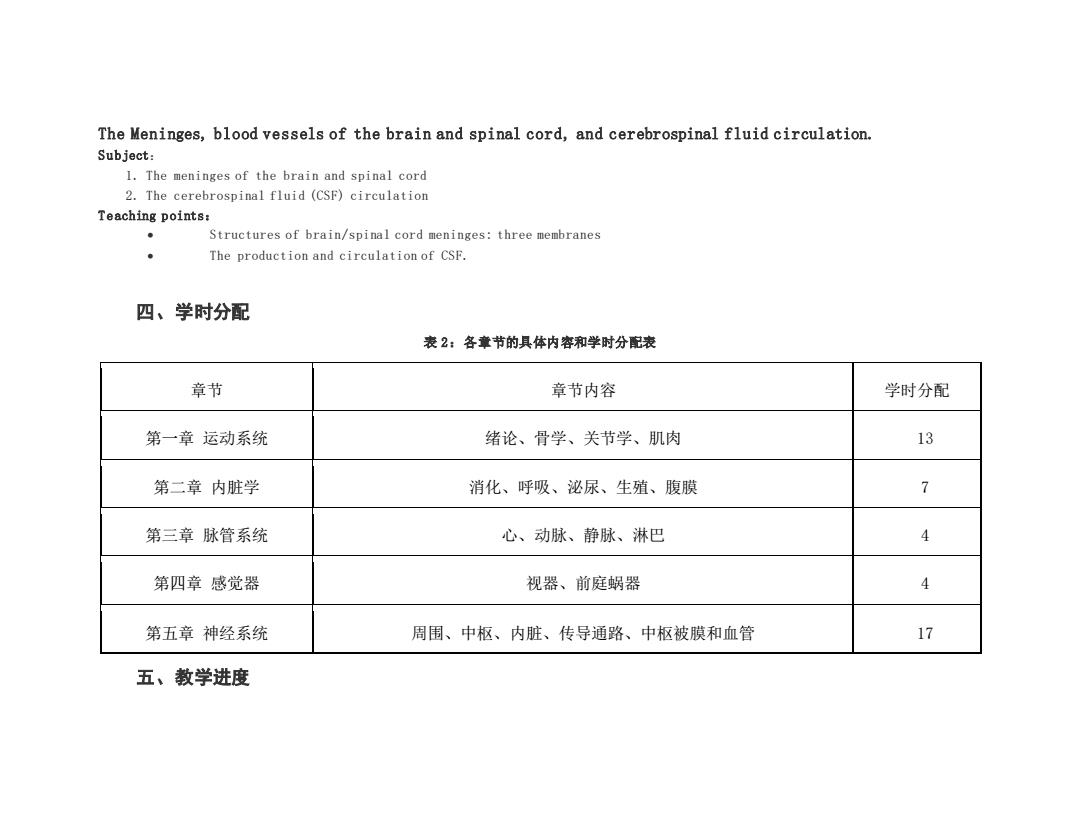
The Meninges,blood vessels of the brain and spinal cord,and cerebrospinal fluid circulation. Subject: 1.The meninges of the brain and spinal cord 2.The cerebrospinal fluid(CSF)circulation Teaching points: Structures of brain/spinal cord meninges:three membranes The production and circulation of CSF. 四、学时分配 表2:各章节的具体内容和学时分配表 章节 章节内容 学时分配 第一章运动系统 绪论、骨学、关节学、肌肉 13 第二章内脏学 消化、呼吸、泌尿、生殖、腹膜 7 第三章脉管系统 心、动脉、静脉、淋巴 4 第四章感觉器 视器、前庭蜗器 4 第五章神经系统 周围、中枢、内脏、传导通路、中枢被膜和血管 17 五、教学进度
The Meninges, blood vessels of the brain and spinal cord, and cerebrospinal fluid circulation. S u bject: 1. The meninges of the brain and spinal cord 2. The cerebrospinal fluid (CSF) circulation T e aching p oints: • Structures of brain/spinal cord meninges: three membranes • The production and circulation of CSF. 四、学时分配 表 2:各章节的具体内容和学时分配表 章节 章节内容 学时分配 第一章 运动系统 绪论、骨学、关节学、肌肉 13 第二章 内脏学 消化、呼吸、泌尿、生殖、腹膜 7 第三章 脉管系统 心、动脉、静脉、淋巴 4 第四章 感觉器 视器、前庭蜗器 4 第五章 神经系统 周围、中枢、内脏、传导通路、中枢被膜和血管 17 五、教学进度
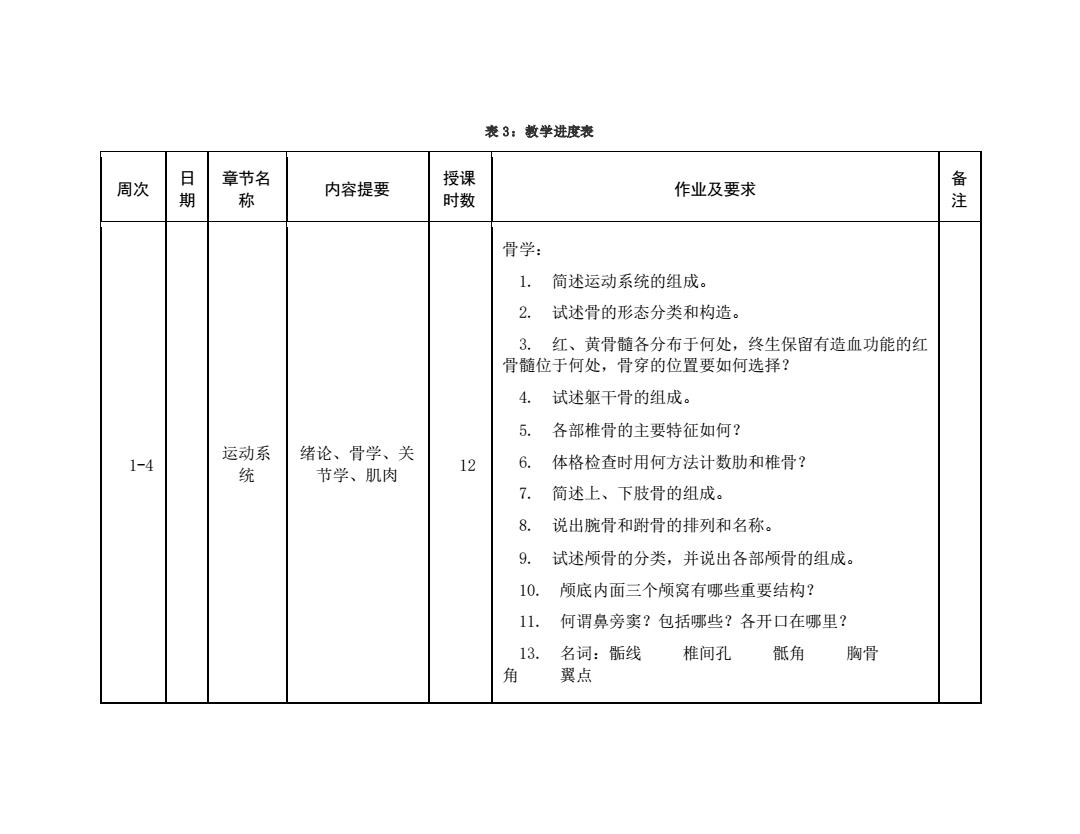
表3:教学进度表 周次 章节名 授课 期 称 内容提要 时数 作业及要求 盒 骨学: 1. 简述运动系统的组成。 2. 试述骨的形态分类和构造。 3.红、黄骨髓各分布于何处,终生保留有造血功能的红 骨髓位于何处,骨穿的位置要如何选择? 4.试述躯干骨的组成。 5.各部椎骨的主要特征如何? 1-4 运动系 绪论、骨学、关 6. 体格检查时用何方法计数肋和椎骨? 统 节学、肌肉 12 7. 简述上、下肢骨的组成。 8. 说出腕骨和跗骨的排列和名称。 9. 试述颅骨的分类,并说出各部颅骨的组成。 10. 颅底内面三个颅窝有哪些重要结构? 11.何谓鼻旁窦?包括哪些?各开口在哪里? 13. 名词:骺线 椎间孔 骶角 胸骨 角 翼点
表 3:教学进度表 周次 日 期 章节名 称 内容提要 授课 时数 作业及要求 备 注 1-4 运动系 统 绪论、骨学、关 节学、肌肉 12 骨学: 1. 简述运动系统的组成。 2. 试述骨的形态分类和构造。 3. 红、黄骨髓各分布于何处,终生保留有造血功能的红 骨髓位于何处,骨穿的位置要如何选择? 4. 试述躯干骨的组成。 5. 各部椎骨的主要特征如何? 6. 体格检查时用何方法计数肋和椎骨? 7. 简述上、下肢骨的组成。 8. 说出腕骨和跗骨的排列和名称。 9. 试述颅骨的分类,并说出各部颅骨的组成。 10. 颅底内面三个颅窝有哪些重要结构? 11. 何谓鼻旁窦?包括哪些?各开口在哪里? 13. 名词:骺线 椎间孔 骶角 胸骨 角 翼点